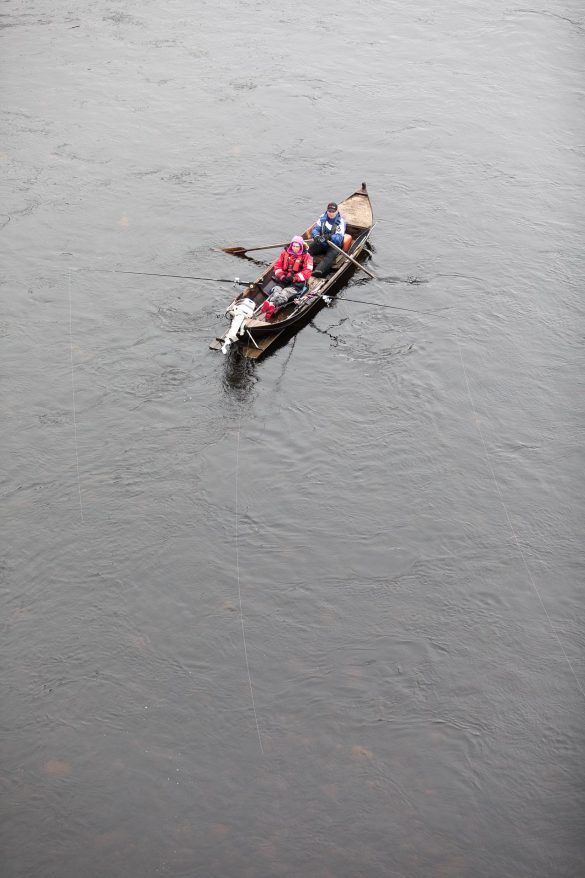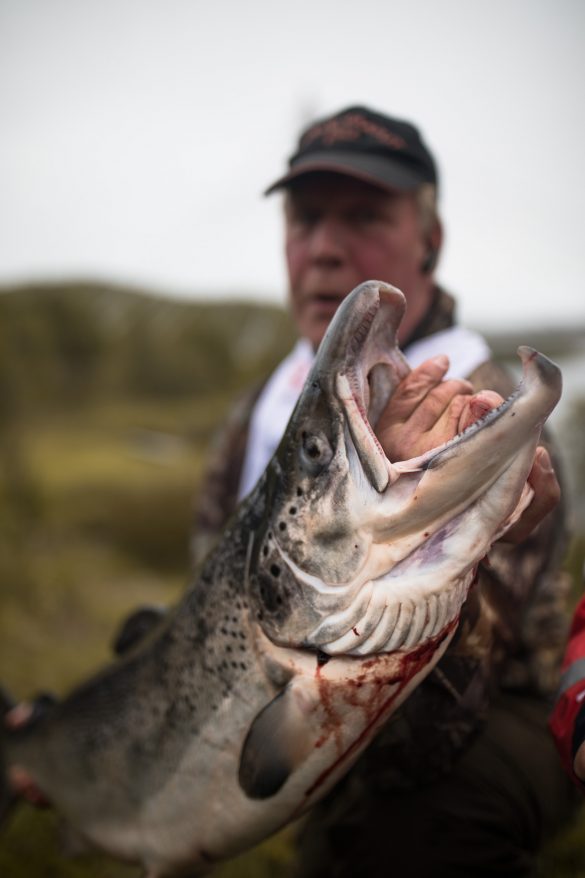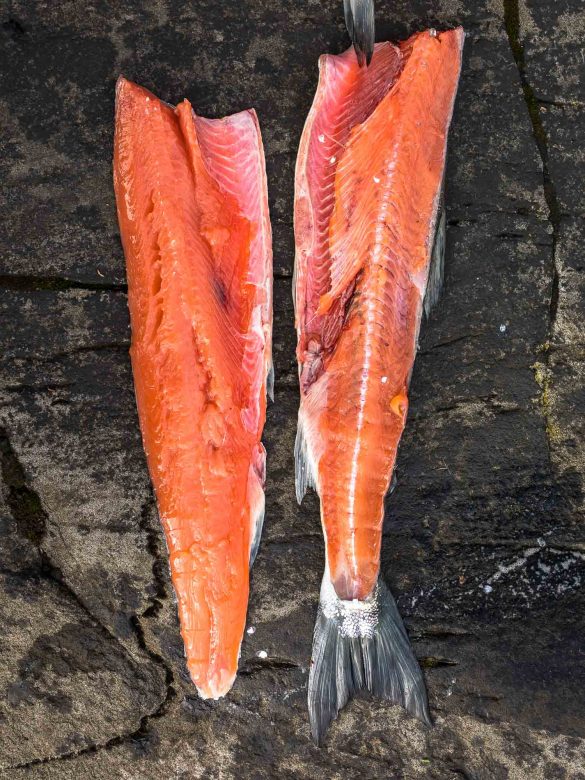Salmo salar (nor.: laks; swe.: lax; fin.: lohi)

This is undoubtedly the king among all fish in the North and you may consider working your way up little by little until you try to tackle this one specific species. Not only are there the most rules and regulations (often involving serious money for a license), you also might need some more advanced techniques and equipment if you want to play with the big boys. The latter quite literally in fact since you’ll find yourself mostly accompanied or even competing with a vast amount of fellow fishermen and –women professionally equipped down to the bone which can be an intimidating experience in itself.
Fishing and Fishing Methods
Atlantic salmon can grow up to more than a meter and unlike its Pacific counterpart it can survive spawning and return to the sea several times. If you feel ready for this particular fish you will find some of the best salmon rivers in the North e.g. Tana river (Tanajoki, Tanaelv), Laks river (Lakselv) or the Alta river (Altaelv). Acquiring a license can set you back some serious money though and rules and regulations are very strict, especially in Norway where you need also to disinfect your gear. If you want to skip complicated licensing and disinfection you can consider e.g. one of the Finnish tributaries of the Tana river, the Utsjoki which is well known for good salmon and grayling catches. You can acquire licenses in the local supermarket on the spot and even ask for some recommendations. A popular spot is about 15 km South of the little border town Utsjoki where the main road crosses the river. Unlike in many other places where it is fly fishing only, you are allowed for lure fishing (using, spinner, spoons, wobbler etc…). However if money is not an issue you might consider other spots.

Spinning
- Wobbler small (0-10 cm)
- Wobbler between (11-20 cm)
- Spinners (over 12 grams)
- Spoons (big)
Fly Fishing
- Tub fly
- Wetflies
- Salmon flies
Angling
- Maggot (winter)
- Shrimp (often forbidden)
- Worm
Trolling
- Wobbler small (0-10 cm)
- Wobbler between (11-20 cm)

Angling Record
- Finland: 27,4 kg
- Sweden: 28,7 kg (freshwater 20,4 kg)
- Norway: N/A
Description
Sometimes it can be difficult to distinguish sea trouts from salmon. In addition to a smaller, sharper head and a thinner tail stem, the notch in the salmon tail is usually much deeper than that of a sea trout. Similarly, in salmon, the upper jaw extends approximately to the edge of the eye, while in sea trouts it goes well behind it. On salmon flanks, dark spotting rarely extends below the rib line, whereas in sea trout, this spotting is common all over the body. In addition, salmon has clearly fewer teeth than sea trout.

Occurrence and origin
In Scandinavia and Finland two ecological forms of salmon are found. Sea salmon (Atlantic salmon) migrate and spawn in rivers descending into the sea. Lake salmon, on the other hand, live their entire lives in freshwater. It wanders in lakes and spawns in rivers flowing into them. The salmon’s original habitat is the northern Atlantic and the Baltic Sea. Lake salmon live e.g. in the Vuoksi watershed, Ladoga, Ääninen and Vänern. In addition to the Vuoksi watershed, Saimaa lake salmon is also planted in other large lakes, such as Lake Inari and Lake Päijänne.
Thanks to the removal of the climbing barriers on the eastern border, Lake Ladoga salmon can also rise again along the Hiitolanjoki River to the Finnish side and has successfully increased under the Kangaskoski power plant for a few years now.
Increase
The spawning of salmon and lake salmon in rivers begins at the time of the spring flood, often peaking in June and continuing until the end of July. The oldest fish appear in spawning grounds first and the youngest a few weeks later. Spawning takes place in late autumn (September, October and sometimes even November) on the shallow gravel bottoms of the stream sites. The eggs hatch inside the bottom gravel over the winter. Young salmon usually spend 3-5 years before the migrate tot he Arctic Ocean or the Baltic Sea. Lake salmon fry usually spend 2-3 years in the river. Migrating hatchlings are between 14-17 cm long when leaving the river and weigh about 20-40 grams. Salmon return to spawning from their sea migration after just one year at sea. A small proportion of male salmon may spawn with larger migratory salmon even before their own migration to the sea.
Generally, males return to spawn after 1 to 4 years at sea and weigh between 2 and 20 kg depending on their age. Female salmon reach sexual maturity after growing in the sea for 2 to 5 years (5 to 20 kg). Lake salmonids are about 4-7 years old when they return to spawning. They then weigh an average of four pounds (3-8 kg). When males return to spawning, females are usually older (5-8 years) and larger (4-9 kg). The majority of the caught salmon are fish aged between 2 and 3 years and the average weight of the catch is about 6-7 kg. A large proportion of spawning salmon die during the winter following spawning, but some spawn more than once, and occasionally go to the sea or lake to grow.
Nutrition, growth and hiking
Salmon river fry feed on zooplankton, small insects and benthic animals in the first summer. Later, the young salmon eat larger insect larvae and adult aquatic insects, which are often carried by the stream. At the beginning of a sea or lake trip, young salmon still feed on surface insects and aquatic invertebrates for some time, but from about 25 inches in size, mostly fish. In the Baltic Sea, the most important food for salmon is herring and sprat, in lakes usually vendace. As an adult, salmon is the fastest growing freshwater fish in the North. There is great variation in salmon growth between years and individuals. After the first sea year, the salmon in the Baltic Sea weigh 1-3 kg, after the second sea year 3-7 kg and after the third year spent at sea 7-13 kg. Lake salmon grow more slowly than sea salmon. In Saimaa, lake salmon weigh about 0.5-0.9 kg after the first lake year, 1.5-3 kg after the second year, and 2-6 kg after the third year. Salmon from the Teno River and the Näätämöjoki River migrate over a large area in the North Atlantic. The main feeding areas for the salmon stocks of the migrating tot he Baltic sea are located in the southern parts of the Baltic Sea, where salmon born at the tops of the Tornionjoki River have to migrate for up to 2,000 km. If there is an abundance of small herring in the Bothnian Sea, some of the salmon may stop to feed there. Salmon in the Gulf of Finland remain mainly in the Gulf of Finland.

Fishing and catches
The salmon catch and the state of salmon stocks in the Baltic Sea are monitored annually. Salmon catches have fallen sharply from peaks in the 1980s and 1990s. Lures and drift lines are the most important salmon traps for professional fishermen. Recreational fishermen catch salmon in the sea area by trolling and from the river areas by both trolling and casting. There is always a minimum size for salmon and the undersize is usually arround 60 cm.

Stock threats, management and endangerment
Environmental changes in rivers flowing into the Baltic Sea have reduced the livelihoods of salmon. Especially rapids have often been harnessed for power generation wastewater has degraded water quality. In Finland for example only two of Finland’s originaly 18 salmon rivers flowing into the Baltic Sea remain. However the situation is similar in Sweden and Southern Norway. Efforts have been made to restore salmon to several rivers through plantings. The biggest threat to salmon stocks in rivers flowing into the Arctic Ocean is Gyrodactylus salaris, a salmonid that has destroyed the salmon population in Norway from about twenty rivers. Strict regulations aim to prevent the spread from the Baltic Sea basin to the rivers flowing into the Arctic Ocean, mainly through transfer bans for live fish, disinfection of fishing gear and education.
